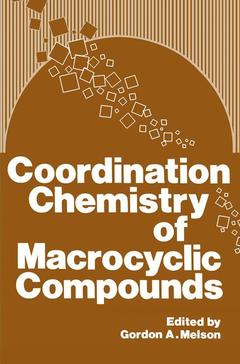1. General Introduction.- 1. Introductory Comments.- 2. General Comments.- 2.1. Definition of a Macrocyclic Compound.- 2.2. Historical Background.- 2.3. Abbreviations of Macrocyclic Compounds.- 2.4. Units.- 2.5. Chapter Layout.- References.- 2. Synthesis of Macrocyclic Complexes.- 1. Introduction.- 2. Tridentate Ligands.- 3. Tetradentate Ligands.- 3.1. N4 Donor Atoms.- 3.2. N2O2 Donor Atoms.- 3.3. N2S2 Donor Atoms.- 3.4. S4 Donor Atoms.- 3.5. P4 and P2S2 Donor Atoms.- 4. Pentadentate Ligands.- 5. Sexadentate Ligands.- 6. Binucleating Ligands.- 7. Clathrochelates.- 8. Conclusions.- References.- 3. Thermodynamics and Kinetics of Cation-Macrocycle Interaction.- 1. Introduction.- 2. Parameters Determining Cation Selectivity and Complex Stability.- 2.1. Relative Sizes of Cation and Ligand Cavity.- 2.2. Arrangement of Ligand Binding Sites.- 2.3. Type and Charge of Cation.- 2.4. Type of Donor Atom.- 2.5. Number of Donor Atoms.- 2.6. Substitution on the Macrocyclic Ring.- 2.7. Solvent.- 3. Macrocyclic Effect.- 3.1. Tetramines.- 3.2. Cyclic Polyethers.- 3.3. Solvation Effects.- 3.4. Mixed Donor Groups.- 3.5. Multiple Juxtapositional Fixedness.- 3.6. Cryptate Effect.- 3.7. Summary.- 4. Table of Thermodynamic Data.- 5. Kinetics.- 5.1. Antibiotic Macrocycles.- 5.2. Cyclic Polyethers.- 5.3. Macrobicyclic Ligands.- References.- 4. Structural Aspects.- 1. Introduction.- 1.1. Scope and Organization.- 1.2. Order of Tabulation.- 2. Class 1: Cyclic Amines-Saturated Polyaza Macrocycles.- 2.1. Introduction.- 2.2. Configurations and Conformations of Coordination Cyclic Tetramines.- 2.3. Metal-Ion-Nitrogen Distances.- 2.4. Substituents on the Macrocycle.- 2.5. Chelate Angles.- 2.6. Listing of Structures of Compounds of Cyclic Amines.- 3. Class 2: Cyclic Imines and Cyclic Amine-Imines (Unsaturated Polyaza Macrocycles with all Nitrogen Atoms Coordinated).- 3.1. Discussion of Structures.- 3.2. Conformation of Macrocycles.- 3.3. Substituents on the Macrocycle.- 3.4. Metal Ion-Nitrogen Distances.- 3.5. Listing of Reported Structures of Cyclic Imine and Cyclic Amine-Imine Compounds.- 4. Class 3: Macrocycles Including a 2,6-Pyridyl Group.- 4.1. Discussion of Structures.- 4.2. Listing of Reported Structures of Compounds of Macrocycles Including a 2,6-Pyridyl Group.- 5. Class 4: Tetraazamacrocycles with 2-Imino(or 2-amido)-benzaldimine Chelate Rings.- 5.1. Discussion of Structures.- 5.2. Listing of Structures of Tetraazamacrocycles with l-Imino(or l-amido)-2-aldiminobenzene Chelate Rings (o-Iminobenzaldimine and o-Amidobenzaldimine Derivatives).- 6. Class 5: Dibenzo[b,i]-l,4,8,11-tetraazacyclotetradec-2,4,6,9,11-hexaenato(2–) Compounds.- 6.1. Discussion of Structures.- 6.2. Listing of Structures of Bzo2[14]hexaenato(2-)N4 Compounds.- 7. Class 6: Cyclic Hydrazines and Hydrazones.- 7.1. Discussion of Structures.- 7.2. Listing of Structures of Cyclic Hydrazine and Hydrazone Compounds.- 8. Class 7: Cyclic Tetraethers and Tetrathiaethers (Tetraoxo- and Tetrathiamacrocycles).- 8.1. Discussion of Structures.- 8.2. Listing of Structures of Tetraoxa- and Tetrathiamacrocycles.- 9. Class 8: Macrocycles with More Than One Type of Heteroatom.- 9.1. Discussion of Structures.- 9.2. Listing of Structures of Compounds.- 10. Class 9: Binucleating Macrocycles.- 10.1. Discussion of Structures.- 10.2. Listing of Structures of Binucleating Macrocycles.- 11. Class 10: Cyclic Phosphazenes.- 11.1. Discussion of Structures.- 11.2. Listing of Structures of Cyclic Phosphazene Compounds.- 12. Class 11: Clathrochelates.- 12.1. Discussion of Structures.- 12.2. Listing of Structures of Clathrochelate Compounds.- 13. Conclusion.- References.- 5. Ligand Field Spectra and Magnetic Properties of Synthetic Macrocyclic Complexes.- 1. Introduction.- 2. Nickel Complexes.- 2.1. Nickel(II) Macrocyclic Complexes.- 2.2. Macrocyclic Complexes of Nickel(I) and Nickel(III).- 3. Copper Complexes.- 3.1. Macrocyclic Copper(II) Complexes.- 3.2. Magnetic Interactions in Binuclear Macrocyclic Copper Complexes.- 3.3. Macrocyclic Complexes of Copper(I) and Copper(III).- 4. Cobalt Complexes.- 4.1. Cobalt(II) Macrocyclic Complexes.- 4.2. Macrocyclic Cobalt(III) Complexes.- 4.3. Cobalt(I) Macrocyclic Complexes.- 5. Iron Complexes.- 5.1. Low-Spin (S = 0) Iron(II) Macrocycles.- 5.2. High-Spin (S = 2) Iron(II) Macrocycles.- 5.3. Intermediate Spin (S = 1) Iron(II) Macrocycles.- 5.4. Low-Spin (S = 1/2) Iron(III) Macrocycles.- 5.5. High-Spin (5 = 5/2) and Intermediate-Spin (S = 3/2) Iron(III) Macrocycles.- 5.6. Other Iron-Containing Macrocycles.- 6. Manganese Complexes.- 6.1. Macrocyclic Complexes of Manganese(II).- 6.2. Macrocyclic Complexes of Manganese(III).- References.- 6. Chemical Reactivity in Constrained Systems.- 1. Introduction.- 2. Predominantly Metal-Centered Reactions.- 2.1. Coordinative Lability.- 2.2. Oxidation-Reduction Reactions of Simple Stoichiometry.- 3. Reactions of the Macrocyclic Ligands.- 3.1. Oxidative Dehydrogenations..- 3.2. Hydrogenation.- 3.3. Substitutions into the Macrocyclic Ligand.- 3.4. N-Alkylations.- 3.5. Additions.- 4. Reactions Involving Free Radicals, Unusual Oxidation States, and Excited States.- 4.1. Free Radical Reactions.- 4.2. Complexes Containing Metals in Unusual Oxidation States.- 4.3. Photochemical Reactions.- 4.4. Photochemistry of Cobalt-Alkyl Complexes.- References.- 7. Metal Complexes of Phthalocyanines.- 1. Introduction.- 2. Molecular Structure.- 3. Electronic Structure.- 4. Spectral Properties.- 5. Synthesis of New Derivatives.- 6. Redox Reactions.- 7. Aggregation of Complexes.- 8. Chromium Complexes.- 9. Manganese Complexes.- 10. Iron Complexes.- 11. Cobalt Complexes.- 12. Group IV Metal Complexes.- 13. Catalytic Activity.- 14. Comparison of Chemistry of Chromium, Manganese, Iron, and Cobalt Complexes.- References.- 8. Coordination Chemistry of Porphyrins.- 1. Introduction.- 2. Synthesis.- 3. Structure.- 4. Reactions.- 5. Chlorins and Corrins.- References.- 9. Physicochemical Studies of Crown and Cryptate Complexes.- 1. Introduction.- 2. Synthetic Methods.- 2.1. Crown Polyethers.- 2.2. [2]-Cryptands.- 2.3. [3]- and [4]-Cryptands.- 3. Metal-Cation Complexes: Preparation and Structure.- 3.1. Monocyclic Ligands (Crowns).- 3.2. Macropolycyclic Ligands (Cryptands).- 4. Complexes in Solutions: Experimental Techniques.- 4.1. General Considerations.- 4.2. Electrochemical Techniques.- 4.3. Spectroscopic Techniques.- 4.4. Extraction Studies.- 4.5. Calorimetric Techniques.- 4.6. Relaxation Techniques.- 5. Conclusion.- References.- 10. Natural-Product Model Systems.- 1. Introduction.- 1.1. Model Systems—Criticisms, Objectives, and Definitions.- 1.2. Importance of X-Ray Structural Analyses.- 1.3. Evolution of Models.- 2. Macrocyclic Complexes as Models.- 2.1. Macrocyclic Ethers and Thiaethers in Model Systems.- 2.2. Synthetic Tetraazamacrocyclic Systems.- 2.3. Fundamental Studies of Synthetic Macrocyclic Ligand Complexes.- 3. Modeling of Heme Proteins.- 3.1. Studies Involving Metals Other than Iron.- 3.2. Iron(II) Carbon Monoxide Complexes.- 3.3. Dioxygen Complexes.- 3.4. Cytochromes.- 4. Binuclear Systems.- 4.1. Cofacial Diporphyrins.- 4.2. Unsymmetrical Binuclear Systems.- 5. Comments on Vitamin B12 and Related Inorganic Systems.- References.




